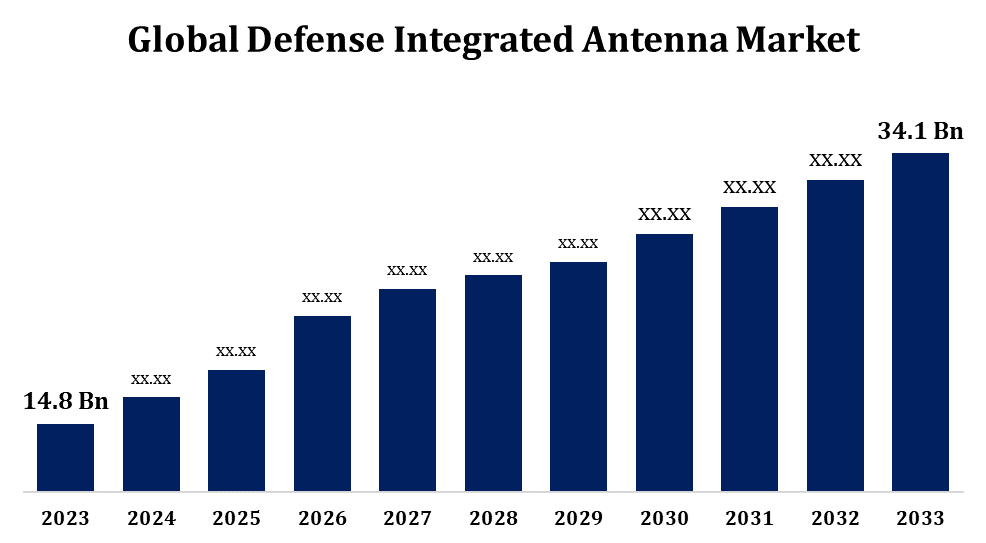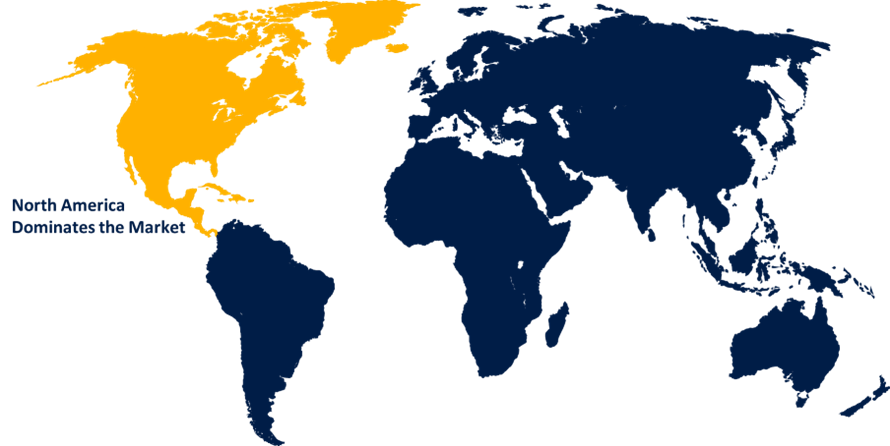Global Defense Integrated Antenna Market Size To Worth USD 34.1 Billion By 2033 | CAGR of 8.70%
Category: Aerospace & DefenseGlobal Defense Integrated Antenna Market Size To Worth USD 34.1 Billion By 2033
According to a research report published by Spherical Insights & Consulting, the Global Defense Integrated Antenna Market Size to Grow from USD 14.8 Billion in 2023 to USD 34.1 Billion by 2033, at a Compound Annual Growth Rate (CAGR) of 8.70% during the forecast period.

Get more details on this report -
Browse key industry insights spread across 236 pages with 110 Market data tables and figures & charts from the report on the "Global Defense Integrated Antenna Market Size, Share, and COVID-19 Impact Analysis, By Component Type (Transmitters, Receivers, Transceivers, Radio Frequency (RF) Switches), By Antenna Type (Fixed Antennas, Conformal Antennas, Phased Array Antennas, Adaptive Antennas), By Platform (Airborne, Ground-based, Naval, Space-based), By Application (Communication Systems, Radar Systems, Electronic Warfare Systems, Navigation Systems), and By Region (North America, Europe, Asia-Pacific, Latin America, Middle East, and Africa), Analysis and Forecast 2023 - 2033." Get Detailed Report Description Here:https://www.sphericalinsights.com/reports/defense-integrated-antenna-market
The Defense Integrated Antenna Market is experiencing rapid growth, driven by expanding defense modernization programs, escalating geopolitical tensions, and advancements in communication technology. These antennas play a vital role in ensuring secure, real-time data transmission for military applications, including radar, electronic warfare, and satellite communications. The demand for lightweight, high-performance antennas with enhanced stealth capabilities is rising, particularly in unmanned systems and next-generation fighter aircraft. North America remains the market leader, benefiting from strong defense budgets and technological advancements, while the Asia-Pacific region is expanding swiftly due to increased military spending. Industry players are prioritizing innovation, miniaturization, and multi-functionality to enhance operational efficiency. Additionally, the integration of artificial intelligence and software-defined radios is expected to further accelerate market growth in the coming years.
Defense Integrated Antenna Market Value Chain Analysis
The Defense Integrated Antenna Market value chain consists of several key stages, from raw material procurement to final deployment. It starts with suppliers providing essential materials such as metals, composites, semiconductors, and advanced dielectric components. Manufacturers then design and produce antennas using advanced technologies, integrating them into defense communication systems. System integrators ensure seamless compatibility with military platforms, including aircraft, naval vessels, and ground-based systems. Rigorous testing and quality assurance processes are essential to meet stringent military standards. Defense contractors and government agencies acquire these antennas for applications in surveillance, electronic warfare, and secure communications. Post-deployment, maintenance and upgrades are crucial for sustained performance. Ongoing collaboration between defense agencies, research institutions, and technology providers continues to drive innovation, enhancing market growth and efficiency.
Defense Integrated Antenna Market Opportunity Analysis
The Defense Integrated Antenna Market offers significant growth opportunities, driven by increasing defense budgets, technological advancements, and evolving warfare strategies. The rising adoption of unmanned systems, next-generation fighter jets, and advanced naval platforms is boosting demand for high-performance antennas with improved stealth, miniaturization, and multi-functionality. Integrating artificial intelligence, 5G, and software-defined radios is unlocking new possibilities, enhancing real-time data exchange and battlefield communication. Emerging markets in the Asia-Pacific and the Middle East present lucrative prospects due to expanding military modernization programs. Additionally, increasing investments in space-based defense infrastructure, including satellite communications and missile defense systems, further drive market expansion. Companies prioritizing research and development, cybersecurity, and cost-effective manufacturing strategies will gain a competitive advantage in this dynamic and evolving industry.
The Defense Integrated Antenna Market is expanding rapidly, driven by the growing demand for advanced defense technologies. Modern military operations depend on sophisticated communication, radar, and electronic warfare systems, increasing the need for high-performance antennas. The rising use of unmanned aerial vehicles (UAVs), next-generation fighter aircraft, and naval defense platforms has accelerated the adoption of lightweight, multi-functional, and stealth-compatible antennas. Advancements in 5G, artificial intelligence, and software-defined radios are enhancing battlefield connectivity and situational awareness. Additionally, increasing investments in satellite-based defense infrastructure and cybersecurity are unlocking new opportunities. Emerging markets in the Asia-Pacific and the Middle East are fueling growth through extensive military modernization programs. Companies prioritizing innovation and cost-effective solutions are well-positioned to capitalize on opportunities in this evolving market.
A major challenge in the Defense Integrated Antenna Market is the high cost of advanced antenna technologies, which restricts adoption, particularly in budget-constrained defense programs. Stringent military regulations and compliance requirements add complexity to manufacturing and integration. The growing demand for miniaturization and multi-functionality presents design challenges, necessitating continuous innovation. Cybersecurity threats and electronic warfare risks further complicate matters, as military communication systems must remain highly secure and resistant to interference. Supply chain disruptions, including shortages of critical raw materials and semiconductors, can delay production timelines. Additionally, the fast-paced evolution of technology requires frequent upgrades, leading to higher maintenance costs. Addressing these challenges requires sustained investment in research, strategic partnerships, and cost-effective manufacturing solutions.
Insights by Component
The Transmitters segment accounted for the largest market share over the forecast period 2023 to 2033. As modern defense operations rely on real-time data transmission, secure and high-frequency transmitters have become vital components of integrated antenna systems. The growing deployment of unmanned aerial vehicles (UAVs), next-generation fighter jets, and naval defense platforms is driving demand for high-power, lightweight, and efficient transmitters. Innovations in software-defined radios, 5G, and satellite-based communications are further accelerating advancements in this segment. Additionally, governments worldwide are investing in next-generation transmitters to strengthen secure battlefield connectivity and surveillance capabilities. With ongoing research and development efforts focused on miniaturization and power efficiency, the transmitters segment is expected to play a key role in shaping the future of defense communication systems.
Insights by Antenna Type
The Phased Array Antennas segment accounted for the largest market share over the forecast period 2023 to 2033. Phased array antennas provide high-speed beam steering, enhanced target tracking, and superior resistance to jamming, making them crucial for modern defense applications. The increasing deployment of next-generation fighter jets, unmanned aerial vehicles (UAVs), and naval defense systems is driving demand for these advanced antennas. Additionally, advancements in active electronically scanned arrays (AESA) are enhancing performance, reducing weight, and improving operational efficiency. Governments and defense agencies worldwide are heavily investing in phased array technology to strengthen surveillance, missile defense, and battlefield connectivity. With ongoing innovations in miniaturization, multi-functionality, and 5G-enabled systems, the phased array antennas segment is poised for significant growth in the coming years.
Insights by Platform
The Airborne segment accounted for the largest market share over the forecast period 2023 to 2033. The expansion of the airborne segment is driven by the increasing deployment of advanced aircraft, unmanned aerial vehicles (UAVs), and military helicopters for surveillance, reconnaissance, and combat missions. Modern defense operations demand high-performance antennas for secure communication, radar, and electronic warfare, fueling the need for lightweight, compact, and multi-functional airborne antennas. The integration of software-defined radios, satellite-based communication, and 5G technology is further enhancing connectivity and operational efficiency. Rising defense budgets and military modernization efforts, particularly in North America and the Asia-Pacific region, are accelerating investments in next-generation airborne systems. Additionally, advancements in stealth technology and phased array antennas are enhancing performance in contested environments. With ongoing R&D efforts, the airborne segment is set for significant growth in the coming years.
Insights by Application
The Communication Systems segment accounted for the largest market share over the forecast period 2023 to 2033. Modern defense operations rely on real-time data transmission for battlefield awareness, command and control, and intelligence sharing, driving the demand for advanced integrated antennas. The growing deployment of unmanned aerial vehicles (UAVs), next-generation fighter jets, and naval platforms has further intensified the need for reliable communication solutions. Key advancements, including software-defined radios, satellite-based communication, and 5G-enabled networks, are improving connectivity, encryption, and resistance to jamming. Increasing defense budgets, particularly in North America and Asia-Pacific, are accelerating investments in next-generation military communication infrastructure. As cyber threats and electronic warfare risks rise, the need for highly secure and adaptive communication systems is expected to fuel significant market growth in the coming years.
Insights by Region

Get more details on this report -
North America is anticipated to dominate the Defense Integrated Antenna Market from 2023 to 2033. As the largest defense spender, the United States invests heavily in next-generation communication, radar, and electronic warfare systems, driving demand for high-performance antennas. The presence of leading defense contractors like Lockheed Martin, Raytheon, and Northrop Grumman fosters innovation in stealth, miniaturization, and multi-functional antenna technologies. The growing adoption of unmanned aerial vehicles (UAVs), satellite-based defense infrastructure, and 5G-enabled battlefield communications further accelerates market expansion. Additionally, government initiatives aimed at strengthening cybersecurity and space-based defense capabilities contribute to industry growth. With continuous R&D investments and strategic collaborations between defense agencies and technology firms, North America remains a key hub for advancements in defense integrated antenna systems.
Asia Pacific is witnessing the fastest market growth between 2023 to 2033. China, India, Japan, and South Korea are making substantial investments in advanced communication, radar, and electronic warfare systems to strengthen their defense capabilities. The growing adoption of unmanned aerial vehicles (UAVs), next-generation fighter jets, and naval defense systems is driving demand for integrated antennas. Additionally, the expansion of satellite-based military communication and surveillance infrastructure is creating new market opportunities. Both local defense manufacturers and international players are prioritizing innovation, indigenous production, and strategic partnerships to enhance regional capabilities. As governments focus on self-reliance and technological advancements, the Asia-Pacific defense integrated antenna market is set for significant growth in the coming years.
Recent Market Developments
- In January 2022, L3Harris Technologies was awarded a USD 750 million IDIQ contract by the US Marine Corps for multi-channel handheld and vehicular radio systems.
Major players in the market
- NEC Corporation
- Thales Group
- SAAB AB
- General Dynamics
- L3Harris Technologies
- Airbus Group
- Raytheon Technologies
- Northrop Grumman
- BAE Systems
- Toshiba Corporation
- Mitsubishi Electric
- Leonardo SpA
- Harris Corporation
- Lockheed Martin
- Rockwell Collins
- Others
Market Segmentation
This study forecasts revenue at global, regional, and country levels from 2023 to 2033.
Defense Integrated Antenna Market, Component Analysis
- Transmitters
- Receivers
- Transceivers
- Radio Frequency (RF) Switches
Defense Integrated Antenna Market, Antenna Type Analysis
- Fixed Antennas
- Conformal Antennas
- Phased Array Antennas
- Adaptive Antennas
Defense Integrated Antenna Market, Platform Analysis
- Airborne
- Ground-based
- Naval
- Space-based
Defense Integrated Antenna Market, Application Analysis
- Communication Systems
- Radar Systems
- Electronic Warfare Systems
- Navigation Systems
Defense Integrated Antenna Market, Regional Analysis
- North America
- US
- Canada
- Mexico
- Europe
- Germany
- Uk
- France
- Italy
- Spain
- Russia
- Rest of Europe
- Asia Pacific
- China
- Japan
- India
- South Korea
- Australia
- Rest of Asia Pacific
- South America
- Brazil
- Argentina
- Rest of South America
- Middle East & Africa
- UAE
- Saudi Arabia
- Qatar
- South Africa
- Rest of the Middle East & Africa
About the Spherical Insights & Consulting
Spherical Insights & Consulting is a market research and consulting firm which provides actionable market research study, quantitative forecasting and trends analysis provides forward-looking insight especially designed for decision makers and aids ROI.
Which is catering to different industry such as financial sectors, industrial sectors, government organizations, universities, non-profits and corporations. The company's mission is to work with businesses to achieve business objectives and maintain strategic improvements.
CONTACT US:
For More Information on Your Target Market, Please Contact Us Below:
Phone: +1 303 800 4326 (the U.S.)
Phone: +91 90289 24100 (APAC)
Email: inquiry@sphericalinsights.com, sales@sphericalinsights.com
Contact Us: https://www.sphericalinsights.com/contact-us
Need help to buy this report?